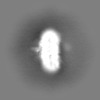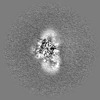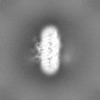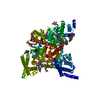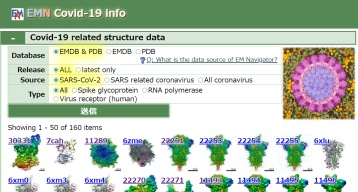[English] 日本語
 Yorodumi
Yorodumi- EMDB-46718: Full-length apo human voltage-gated sodium channel 1.8 (NaV1.8) -
+ Open data
Open data
- Basic information
Basic information
| Entry |  | |||||||||
|---|---|---|---|---|---|---|---|---|---|---|
| Title | Full-length apo human voltage-gated sodium channel 1.8 (NaV1.8) | |||||||||
 Map data Map data | ||||||||||
 Sample Sample |
| |||||||||
 Keywords Keywords | ion channel / MEMBRANE PROTEIN | |||||||||
| Function / homology |  Function and homology information Function and homology informationbundle of His cell action potential / AV node cell action potential / clathrin complex / regulation of atrial cardiac muscle cell membrane depolarization / membrane depolarization during action potential / voltage-gated monoatomic ion channel activity involved in regulation of presynaptic membrane potential / sensory perception / regulation of monoatomic ion transmembrane transport / cardiac muscle cell action potential involved in contraction / voltage-gated sodium channel complex ...bundle of His cell action potential / AV node cell action potential / clathrin complex / regulation of atrial cardiac muscle cell membrane depolarization / membrane depolarization during action potential / voltage-gated monoatomic ion channel activity involved in regulation of presynaptic membrane potential / sensory perception / regulation of monoatomic ion transmembrane transport / cardiac muscle cell action potential involved in contraction / voltage-gated sodium channel complex / Interaction between L1 and Ankyrins / voltage-gated sodium channel activity / Phase 0 - rapid depolarisation / odontogenesis of dentin-containing tooth / regulation of cardiac muscle contraction / sodium ion transmembrane transport / regulation of heart rate / presynaptic membrane / transmembrane transporter binding / axon / glutamatergic synapse / extracellular exosome / plasma membrane Similarity search - Function | |||||||||
| Biological species |  Homo sapiens (human) Homo sapiens (human) | |||||||||
| Method | single particle reconstruction / cryo EM / Resolution: 3.12 Å | |||||||||
 Authors Authors | Neumann B / McCarthy S / Gonen S | |||||||||
| Funding support |  United States, 2 items United States, 2 items
| |||||||||
 Citation Citation |  Journal: Nat Commun / Year: 2025 Journal: Nat Commun / Year: 2025Title: Structural basis of inhibition of human Na1.8 by the tarantula venom peptide Protoxin-I. Authors: Bryan Neumann / Stephen McCarthy / Shane Gonen /  Abstract: Voltage-gated sodium channels (Nas) selectively permit diffusion of sodium ions across the cell membrane and, in excitable cells, are responsible for propagating action potentials. One of the nine ...Voltage-gated sodium channels (Nas) selectively permit diffusion of sodium ions across the cell membrane and, in excitable cells, are responsible for propagating action potentials. One of the nine human Na isoforms, Na1.8, is a promising target for analgesics, and selective inhibitors are of interest as therapeutics. One such inhibitor, the gating-modifier peptide Protoxin-I derived from tarantula venom, blocks channel opening by shifting the activation voltage threshold to more depolarized potentials, but the structural basis for this inhibition has not previously been determined. Using monolayer graphene grids, we report the cryogenic electron microscopy structures of full-length human apo-Na1.8 and the Protoxin-I-bound complex at 3.1 Å and 2.8 Å resolution, respectively. The apo structure shows an unexpected movement of the Domain I S4-S5 helix, and VSD was unresolvable. We find that Protoxin-I binds to and displaces the VSD S3-S4 linker, hindering translocation of the S4 helix during activation. | |||||||||
| History |
|
- Structure visualization
Structure visualization
| Supplemental images |
|---|
- Downloads & links
Downloads & links
-EMDB archive
| Map data |  emd_46718.map.gz emd_46718.map.gz | 88.6 MB |  EMDB map data format EMDB map data format | |
|---|---|---|---|---|
| Header (meta data) |  emd-46718-v30.xml emd-46718-v30.xml emd-46718.xml emd-46718.xml | 27 KB 27 KB | Display Display |  EMDB header EMDB header |
| FSC (resolution estimation) |  emd_46718_fsc.xml emd_46718_fsc.xml | 12 KB | Display |  FSC data file FSC data file |
| Images |  emd_46718.png emd_46718.png | 50.1 KB | ||
| Masks |  emd_46718_msk_1.map emd_46718_msk_1.map emd_46718_msk_2.map emd_46718_msk_2.map | 178 MB 178 MB |  Mask map Mask map | |
| Filedesc metadata |  emd-46718.cif.gz emd-46718.cif.gz | 8.2 KB | ||
| Others |  emd_46718_additional_1.map.gz emd_46718_additional_1.map.gz emd_46718_additional_2.map.gz emd_46718_additional_2.map.gz emd_46718_additional_3.map.gz emd_46718_additional_3.map.gz emd_46718_half_map_1.map.gz emd_46718_half_map_1.map.gz emd_46718_half_map_2.map.gz emd_46718_half_map_2.map.gz | 168 MB 8.7 MB 9.3 MB 165 MB 165 MB | ||
| Archive directory |  http://ftp.pdbj.org/pub/emdb/structures/EMD-46718 http://ftp.pdbj.org/pub/emdb/structures/EMD-46718 ftp://ftp.pdbj.org/pub/emdb/structures/EMD-46718 ftp://ftp.pdbj.org/pub/emdb/structures/EMD-46718 | HTTPS FTP |
-Validation report
| Summary document |  emd_46718_validation.pdf.gz emd_46718_validation.pdf.gz | 1.2 MB | Display |  EMDB validaton report EMDB validaton report |
|---|---|---|---|---|
| Full document |  emd_46718_full_validation.pdf.gz emd_46718_full_validation.pdf.gz | 1.2 MB | Display | |
| Data in XML |  emd_46718_validation.xml.gz emd_46718_validation.xml.gz | 20.6 KB | Display | |
| Data in CIF |  emd_46718_validation.cif.gz emd_46718_validation.cif.gz | 26.6 KB | Display | |
| Arichive directory |  https://ftp.pdbj.org/pub/emdb/validation_reports/EMD-46718 https://ftp.pdbj.org/pub/emdb/validation_reports/EMD-46718 ftp://ftp.pdbj.org/pub/emdb/validation_reports/EMD-46718 ftp://ftp.pdbj.org/pub/emdb/validation_reports/EMD-46718 | HTTPS FTP |
-Related structure data
| Related structure data |  9dbkMC  9dblC  9dbmC  9dbnC M: atomic model generated by this map C: citing same article ( |
|---|---|
| Similar structure data | Similarity search - Function & homology  F&H Search F&H Search |
- Links
Links
| EMDB pages |  EMDB (EBI/PDBe) / EMDB (EBI/PDBe) /  EMDataResource EMDataResource |
|---|---|
| Related items in Molecule of the Month |
- Map
Map
| File |  Download / File: emd_46718.map.gz / Format: CCP4 / Size: 178 MB / Type: IMAGE STORED AS FLOATING POINT NUMBER (4 BYTES) Download / File: emd_46718.map.gz / Format: CCP4 / Size: 178 MB / Type: IMAGE STORED AS FLOATING POINT NUMBER (4 BYTES) | ||||||||||||||||||||||||||||||||||||
|---|---|---|---|---|---|---|---|---|---|---|---|---|---|---|---|---|---|---|---|---|---|---|---|---|---|---|---|---|---|---|---|---|---|---|---|---|---|
| Projections & slices | Image control
Images are generated by Spider. | ||||||||||||||||||||||||||||||||||||
| Voxel size | X=Y=Z: 0.839 Å | ||||||||||||||||||||||||||||||||||||
| Density |
| ||||||||||||||||||||||||||||||||||||
| Symmetry | Space group: 1 | ||||||||||||||||||||||||||||||||||||
| Details | EMDB XML:
|
-Supplemental data
-Mask #1
| File |  emd_46718_msk_1.map emd_46718_msk_1.map | ||||||||||||
|---|---|---|---|---|---|---|---|---|---|---|---|---|---|
| Projections & Slices |
| ||||||||||||
| Density Histograms |
-Mask #2
| File |  emd_46718_msk_2.map emd_46718_msk_2.map | ||||||||||||
|---|---|---|---|---|---|---|---|---|---|---|---|---|---|
| Projections & Slices |
| ||||||||||||
| Density Histograms |
-Additional map: sharpened
| File | emd_46718_additional_1.map | ||||||||||||
|---|---|---|---|---|---|---|---|---|---|---|---|---|---|
| Annotation | sharpened | ||||||||||||
| Projections & Slices |
| ||||||||||||
| Density Histograms |
-Additional map: local res
| File | emd_46718_additional_2.map | ||||||||||||
|---|---|---|---|---|---|---|---|---|---|---|---|---|---|
| Annotation | local res | ||||||||||||
| Projections & Slices |
| ||||||||||||
| Density Histograms |
-Additional map: filtered
| File | emd_46718_additional_3.map | ||||||||||||
|---|---|---|---|---|---|---|---|---|---|---|---|---|---|
| Annotation | filtered | ||||||||||||
| Projections & Slices |
| ||||||||||||
| Density Histograms |
-Half map: #1
| File | emd_46718_half_map_1.map | ||||||||||||
|---|---|---|---|---|---|---|---|---|---|---|---|---|---|
| Projections & Slices |
| ||||||||||||
| Density Histograms |
-Half map: #2
| File | emd_46718_half_map_2.map | ||||||||||||
|---|---|---|---|---|---|---|---|---|---|---|---|---|---|
| Projections & Slices |
| ||||||||||||
| Density Histograms |
- Sample components
Sample components
-Entire : Sodium channel protein type 10 subunit alpha
| Entire | Name: Sodium channel protein type 10 subunit alpha |
|---|---|
| Components |
|
-Supramolecule #1: Sodium channel protein type 10 subunit alpha
| Supramolecule | Name: Sodium channel protein type 10 subunit alpha / type: complex / ID: 1 / Parent: 0 / Macromolecule list: #1 |
|---|---|
| Source (natural) | Organism:  Homo sapiens (human) Homo sapiens (human) |
-Macromolecule #1: Sodium channel protein type 10 subunit alpha
| Macromolecule | Name: Sodium channel protein type 10 subunit alpha / type: protein_or_peptide / ID: 1 / Number of copies: 1 / Enantiomer: LEVO |
|---|---|
| Source (natural) | Organism:  Homo sapiens (human) Homo sapiens (human) |
| Molecular weight | Theoretical: 225.721281 KDa |
| Recombinant expression | Organism:  Homo sapiens (human) Homo sapiens (human) |
| Sequence | String: DYKDDDDKSA WSHPQFEKGG GSGGGSGGSA WSHPQFEKEN LYFQSMEFPI GSLETNNFRR FTPESLVEIE KQIAAKQGTK KAREKHREQ KDQEEKPRPQ LDLKACNQLP KFYGELPAEL IGEPLEDLDP FYSTHRTFMV LNKGRTISRF SATRALWLFS P FNLIRRTA ...String: DYKDDDDKSA WSHPQFEKGG GSGGGSGGSA WSHPQFEKEN LYFQSMEFPI GSLETNNFRR FTPESLVEIE KQIAAKQGTK KAREKHREQ KDQEEKPRPQ LDLKACNQLP KFYGELPAEL IGEPLEDLDP FYSTHRTFMV LNKGRTISRF SATRALWLFS P FNLIRRTA IKVSVHSWFS LFITVTILVN CVCMTRTDLP EKIEYVFTVI YTFEALIKIL ARGFCLNEFT YLRDPWNWLD FS VITLAYV GTAIDLRGIS GLRTFRVLRA LKTVSVIPGL KVIVGALIHS VKKLADVTIL TIFCLSVFAL VGLQLFKGNL KNK CVKNDM AVNETTNYSS HRKPDIYINK RGTSDPLLCG NGSDSGHCPD GYICLKTSDN PDFNYTSFDS FAWAFLSLFR LMTQ DSWER LYQQTLRTSG KIYMIFFVLV IFLGSFYLVN LILAVVTMAY EEQNQATTDE IEAKEKKFQE ALEMLRKEQE VLAAL GIDT TSLHSHNGSP LTSKNASERR HRIKPRVSEG STEDNKSPRS DPYNQRRMSF LGLASGKRRA SHGSVFHFRS PGRDIS LPE GVTDDGVFPG DHESHRGSLL LGGGAGQQGP LPRSPLPQPS NPDSRHGEDE HQPPPTSELA PGAVDVSAFD AGQKKTF LS AEYLDEPFRA QRAMSVVSII TSVLEELEES EQKCPPCLTS LSQKYLIWDC CPMWVKLKTI LFGLVTDPFA ELTITLCI V VNTIFMAMEH HGMSPTFEAM LQIGNIVFTI FFTAEMVFKI IAFDPYYYFQ KKWNIFDCII VTVSLLELGV AKKGSLSVL RSFRLLRVFK LAKSWPTLNT LIKIIGNSVG ALGNLTIILA IIVFVFALVG KQLLGENYRN NRKNISAPHE DWPRWHMHDF FHSFLIVFR ILCGEWIENM WACMEVGQKS ICLILFLTVM VLGNLVVLNL FIALLLNSFS ADNLTAPEDD GEVNNLQVAL A RIQVFGHR TKQALCSFFS RSCPFPQPKA EPELVVKLPL SSSKAENHIA ANTARGSSGG LQAPRGPRDE HSDFIANPTV WV SVPIAEG ESDLDDLEDD GGEDAQSFQQ EVIPKGQQEQ LQQVERCGDH LTPRSPGTGT SSEDLAPSLG ETWKDESVPQ VPA EGVDDT SSSEGSTVDC LDPEEILRKI PELADDLEEP DDCFTEGCIR HCPCCKLDTT KSPWDVGWQV RKTCYRIVEH SWFE SFIIF MILLSSGSLA FEDYYLDQKP TVKALLEYTD RVFTFIFVFE MLLKWVAYGF KKYFTNAWCW LDFLIVNISL ISLTA KILE YSEVAPIKAL RTLRALRPLR ALSRFEGMRV VVDALVGAIP SIMNVLLVCL IFWLIFSIMG VNLFAGKFWR CINYTD GEF SLVPLSIVNN KSDCKIQNST GSFFWVNVKV NFDNVAMGYL ALLQVATFKG WMDIMYAAVD SREVNMQPKW EDNVYMY LY FVIFIIFGGF FTLNLFVGVI IDNFNQQKKK LGGQDIFMTE EQKKYYNAMK KLGSKKPQKP IPRPLNKFQG FVFDIVTR Q AFDITIMVLI CLNMITMMVE TDDQSEEKTK ILGKINQFFV AVFTGECVMK MFALRQYYFT NGWNVFDFIV VVLSIASLI FSAILKSLQS YFSPTLFRVI RLARIGRILR LIRAAKGIRT LLFALMMSLP ALFNIGLLLF LVMFIYSIFG MSSFPHVRWE AGIDDMFNF QTFANSMLCL FQITTSAGWD GLLSPILNTG PPYCDPNLPN SNGTRGDCGS PAVGIIFFTT YIIISFLIVV N MYIAVILE NFNVATEEST EPLSEDDFDM FYETWEKFDP EATQFITFSA LSDFADTLSG PLRIPKPNRN ILIQMDLPLV PG DKIHCLD ILFAFTKNVL GESGELDSLK ANMEEKFMAT NLSKSSYEPI ATTLRWKQED ISATVIQKAY RSYVLHRSMA LSN TPCVPR AEEEAASLPD EGFVAFTANE NCVLPDKSET ASATSFPPSY ESVTRGLSDR VNMRTSSSIQ NEDEATSMEL IAPG P UniProtKB: Sodium channel protein type 10 subunit alpha |
-Macromolecule #4: CHOLESTEROL
| Macromolecule | Name: CHOLESTEROL / type: ligand / ID: 4 / Number of copies: 5 / Formula: CLR |
|---|---|
| Molecular weight | Theoretical: 386.654 Da |
| Chemical component information | 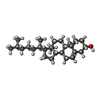 ChemComp-CLR: |
-Macromolecule #5: 1,2-DIOLEOYL-SN-GLYCERO-3-PHOSPHOCHOLINE
| Macromolecule | Name: 1,2-DIOLEOYL-SN-GLYCERO-3-PHOSPHOCHOLINE / type: ligand / ID: 5 / Number of copies: 3 / Formula: PCW |
|---|---|
| Molecular weight | Theoretical: 787.121 Da |
| Chemical component information | 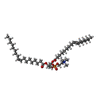 ChemComp-PCW: |
-Macromolecule #6: 1-O-OCTADECYL-SN-GLYCERO-3-PHOSPHOCHOLINE
| Macromolecule | Name: 1-O-OCTADECYL-SN-GLYCERO-3-PHOSPHOCHOLINE / type: ligand / ID: 6 / Number of copies: 7 / Formula: LPE |
|---|---|
| Molecular weight | Theoretical: 510.708 Da |
| Chemical component information |  ChemComp-LPE: |
-Macromolecule #7: O-[(R)-{[(2R)-2,3-bis(octadecanoyloxy)propyl]oxy}(hydroxy)phospho...
| Macromolecule | Name: O-[(R)-{[(2R)-2,3-bis(octadecanoyloxy)propyl]oxy}(hydroxy)phosphoryl]-L-serine type: ligand / ID: 7 / Number of copies: 2 / Formula: P5S |
|---|---|
| Molecular weight | Theoretical: 792.075 Da |
| Chemical component information | 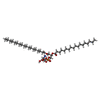 ChemComp-P5S: |
-Experimental details
-Structure determination
| Method | cryo EM |
|---|---|
 Processing Processing | single particle reconstruction |
| Aggregation state | particle |
- Sample preparation
Sample preparation
| Concentration | 0.25 mg/mL | ||||||||||||
|---|---|---|---|---|---|---|---|---|---|---|---|---|---|
| Buffer | pH: 7.5 Component:
| ||||||||||||
| Grid | Model: Quantifoil R2/4 / Material: GOLD / Mesh: 300 / Support film - #0 - Film type ID: 1 / Support film - #0 - Material: CARBON / Support film - #0 - topology: HOLEY / Support film - #1 - Film type ID: 2 / Support film - #1 - Material: GRAPHENE / Support film - #1 - topology: CONTINUOUS / Support film - #1 - Film thickness: 0.4 / Pretreatment - Type: GLOW DISCHARGE / Pretreatment - Time: 30 sec. / Pretreatment - Atmosphere: AIR Details: Negatively glow discharged with the graphene facing up | ||||||||||||
| Vitrification | Cryogen name: ETHANE / Chamber humidity: 96 % / Chamber temperature: 283 K / Instrument: LEICA EM GP |
- Electron microscopy
Electron microscopy
| Microscope | FEI TITAN KRIOS |
|---|---|
| Specialist optics | Energy filter - Name: GIF Bioquantum / Energy filter - Slit width: 20 eV |
| Image recording | Film or detector model: GATAN K3 (6k x 4k) / Number real images: 13124 / Average electron dose: 60.0 e/Å2 |
| Electron beam | Acceleration voltage: 300 kV / Electron source:  FIELD EMISSION GUN FIELD EMISSION GUN |
| Electron optics | Illumination mode: FLOOD BEAM / Imaging mode: BRIGHT FIELD / Cs: 2.7 mm / Nominal defocus max: 2.5 µm / Nominal defocus min: 1.0 µm / Nominal magnification: 105000 |
| Sample stage | Specimen holder model: FEI TITAN KRIOS AUTOGRID HOLDER / Cooling holder cryogen: NITROGEN |
| Experimental equipment | 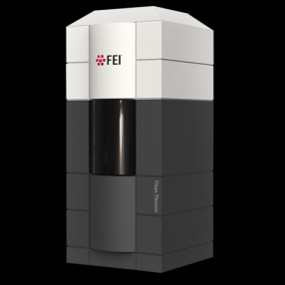 Model: Titan Krios / Image courtesy: FEI Company |
 Movie
Movie Controller
Controller






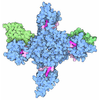

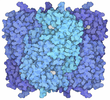
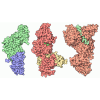
 Z (Sec.)
Z (Sec.) Y (Row.)
Y (Row.) X (Col.)
X (Col.)



